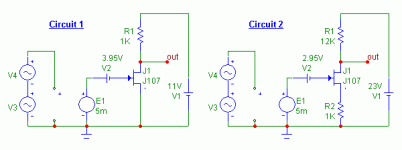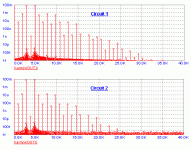I don't think anyone has refered to it so far so members may be interested in this paper from the following Caltech site. It is a fairly detailed analysis of the effects of feedback (or lack of it) on simple FETs, BJTs, and valves/tubes circuits. http://www.its.caltech.edu/~musiclab/feedback-paper-acrobat.pdf it's also available in Postcript format.
An interesting paper, but in reading it casually I perceive
a couple of difficulties.
1) It appear to be all simulation. I would very much prefer
to see a real live case. When I see components at -150 dB
(which is what I thought was portrayed), we are starting
to talk 1 part in 30 million. Given the amount of computation
required, round off and other math errors could easily be sitting
at this level.
2) Comparing degenerated circuits to non-degenerated is
like apples and oranges. For the same output, the input
signal has to be increased, and we enter new territory where
not all things are the same.
a couple of difficulties.
1) It appear to be all simulation. I would very much prefer
to see a real live case. When I see components at -150 dB
(which is what I thought was portrayed), we are starting
to talk 1 part in 30 million. Given the amount of computation
required, round off and other math errors could easily be sitting
at this level.
2) Comparing degenerated circuits to non-degenerated is
like apples and oranges. For the same output, the input
signal has to be increased, and we enter new territory where
not all things are the same.
Dear Nelson, may I comment?
While my personal relationships with James Boyk is not warm enough, I must admit, that I consider him as one of the most experienced experts in the field of music performance to music recording. His book "To Hear Ourselves As Others Hear Us" is based on hearing, not simulation. The main idea of their paper "Small-signal distortion in feedback amplifiers for audio" is to explain the audible difference between microphone amps without- and with- NFB, which they explain as the seeming addition of improper super tweeter to the system. The simulation itself was not their aim; they had followed and extended Baxandall paper.
p.s. I start to agree with our prematurely retired member opinion that the high-end design means high-ego design instead. Haven’t ever heard on this forum from "experienced audio designers" that this design is nice, or this or that approach is interesting, each time with some reservations. The best one was they have checked it thirty years ago and it didn't sound good. Sorry big guys, it becomes boring.
While my personal relationships with James Boyk is not warm enough, I must admit, that I consider him as one of the most experienced experts in the field of music performance to music recording. His book "To Hear Ourselves As Others Hear Us" is based on hearing, not simulation. The main idea of their paper "Small-signal distortion in feedback amplifiers for audio" is to explain the audible difference between microphone amps without- and with- NFB, which they explain as the seeming addition of improper super tweeter to the system. The simulation itself was not their aim; they had followed and extended Baxandall paper.
p.s. I start to agree with our prematurely retired member opinion that the high-end design means high-ego design instead. Haven’t ever heard on this forum from "experienced audio designers" that this design is nice, or this or that approach is interesting, each time with some reservations. The best one was they have checked it thirty years ago and it didn't sound good. Sorry big guys, it becomes boring.
Interesting article Jonathan,
Did do a quick scan, but the authors do not draw any conclusions. This discussion is ongoing for at least 5 decades without being conclusive. Will read the paper more extensively next weekend. It contains maybe some fuel for more discussion.
Cheers 😉
Did do a quick scan, but the authors do not draw any conclusions. This discussion is ongoing for at least 5 decades without being conclusive. Will read the paper more extensively next weekend. It contains maybe some fuel for more discussion.
Cheers 😉
Dimitri, I hear what you're saying, but if you look at my posts,
you will often enough see a compliment without reservations.
Just look at them over the last 48 hours or so.
On the other hand, while I count myself as having a "semi-warm
relationship" with Mr. Boyk, I still would like to have seen an
example of measurements on a real circuit (which certainly is
easy enough to build).
Perhaps I'll just have to do it myself. 😎
you will often enough see a compliment without reservations.
Just look at them over the last 48 hours or so.
On the other hand, while I count myself as having a "semi-warm
relationship" with Mr. Boyk, I still would like to have seen an
example of measurements on a real circuit (which certainly is
easy enough to build).
Perhaps I'll just have to do it myself. 😎
Dear Nelson, you don't need to make the measurements, as they were done before. I didn't comment on your specific post or posts, I would like to share my overall impressions about the forum in the course of the last year. While the specific posts can be cited and discussed, I feel I'll better don't touch this.
I can send to interested parties two last papers from Baxandall series - Audio power amplifier design -"Negative feedback and non-linearity distortion" in pdf form. Send your e-mails to ddanyuk<at>usa<dot>net
I can send to interested parties two last papers from Baxandall series - Audio power amplifier design -"Negative feedback and non-linearity distortion" in pdf form. Send your e-mails to ddanyuk<at>usa<dot>net
>Dimitri, it seems from the research you quoted that the best sonic results are obtained either with no overall feedback or with a lot of overall feedback, but not with low feedback.<
My findings have also been similar. Subjectively, many of the circuits that I have experimented with seem to exhibit a double bell-curve when it comes to how to proportion local and global feedback vs. statistics of how listeners like or dislike the sound. The two bells tend to be low global feedback (less than 10dB), and high global feedback (50~60dB). However, I have not found that "no feedback" is necessary, as circuits with (for example) 6dB or so of feedback didn't seem to be subjectively dislikeable by any means.
Also, individual listeners show differences in the amounts of global feedback that they prefer. I have yet to find a combination of circuit and global feedback amount where every listener that I played it for said "This is perfect. Don't change a thing." Ask different listeners, and you get different responses, and in many cases, for what appear to be equally valid reasons. In the end, the designer needs to make the decision himself, and that is a personal choice.
hth, jonathan carr
My findings have also been similar. Subjectively, many of the circuits that I have experimented with seem to exhibit a double bell-curve when it comes to how to proportion local and global feedback vs. statistics of how listeners like or dislike the sound. The two bells tend to be low global feedback (less than 10dB), and high global feedback (50~60dB). However, I have not found that "no feedback" is necessary, as circuits with (for example) 6dB or so of feedback didn't seem to be subjectively dislikeable by any means.
Also, individual listeners show differences in the amounts of global feedback that they prefer. I have yet to find a combination of circuit and global feedback amount where every listener that I played it for said "This is perfect. Don't change a thing." Ask different listeners, and you get different responses, and in many cases, for what appear to be equally valid reasons. In the end, the designer needs to make the decision himself, and that is a personal choice.
hth, jonathan carr
offtopic to jonathan
Dear Jonathan, I understand that your mail-box is full of spam, p***s enlardgement, etc., etc. Please contact me.
Dear Jonathan, I understand that your mail-box is full of spam, p***s enlardgement, etc., etc. Please contact me.
"Is it possible to create any active circuit with zero feedback? "
technically, it is hard to do that in the analog domain. But in the digital domain, it is probably the opposite, 🙂.
I would agree that "zero feedback" is mostly a marketing tool.
technically, it is hard to do that in the analog domain. But in the digital domain, it is probably the opposite, 🙂.
I would agree that "zero feedback" is mostly a marketing tool.
I suppose a digital FIR filter is without feedback, but what about the input and output circuits? There is not much fun about a filter when it has no interface to the analogue world.
\Jens
\Jens
Nelson Pass said:2) Comparing degenerated circuits to non-degenerated is
like apples and oranges. For the same output, the input
signal has to be increased, and we enter new territory where
not all things are the same.
Indeed Nelson,
I want to highlight one remarkable observation in Boyk‘s article. He states that adding a source resistor to a fet as a feedback mechanism introduces extra (intermodulation) distortion. He also speculates that this can be a reason intermodulation noise blurs the sound we perceive. He also models a fet as a pure quadratic function. Well that is far from what a real fet is. Drawing conclusions or speculations from that is nonsense to me.
Did do some simulations in PSpice for a 2SJ107 fet. Although it is tricky to do distortion simulations in PSpice also, the models are at least way better than a simple quadratic model.
For the simulations I set the gain for both circuits to 10, the same as Boyk did and used also 2 signals with a 3 : 5 ratio. Amplitude of both signals is the same 5 mV. Attached the circuits used. Supply voltage for both circuits is set to a voltage so that the D-S voltage is 10V for both circuits.
Attachments
Here the results. Have included the computational noise floor, which is app –260 dB down. We see that there are no new intermodulation products introduced by adding feedback. Al intermodudulation products are lowered some 30 dB. But more important, the relative magnitude of the intermodulation products stays nearly the same for a circuit with feedbach and a circuit without feedback. Only at higher frequencies, where frequency dependent mechanisms come in, there is a little deviation.
IMHO Boyk did a nice theoretical exercise but there is no resemblance with a real circuit, at least not for the single fet circuit. It does not really clarify the sonically difference we observe. Without verification to a real circuit it only fuels wild speculations.
Cheers 😉
IMHO Boyk did a nice theoretical exercise but there is no resemblance with a real circuit, at least not for the single fet circuit. It does not really clarify the sonically difference we observe. Without verification to a real circuit it only fuels wild speculations.
Cheers 😉
Attachments
- Status
- Not open for further replies.
- Home
- Amplifiers
- Solid State
- Is it possible to create any active circuit with zero feedback?


